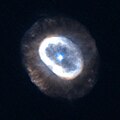Andromeda (constellation)
Andromeda is a constellation in the northern sky. It is named after the princess Andromeda in Greek mythology. It is sometimes called "Princess of Ethiopia" or "the Chained Woman" in English.[1] It has also been called Persea ("Perseus's wife")[1] or Cepheis ("Cepheus's daughter").[1] The astronomer named Ptolemy listed Andromeda when he made a list of 48 constellations. It is also one of the 88 constellations made by the International Astronomical Union.[2]
 Click for larger image | |
| List of stars in Andromeda | |
| Abbreviation: | And |
| Genitive: | Andromedae |
| Symbology: | |
| Right ascension: | 1 h |
| Declination: | +40° |
| Area: | 722 sq. deg. (19th) |
| Main stars: | 4, 18 |
| Bayer/Flamsteed stars: | 65 |
| Stars known to have planets: | 8 |
| Bright stars: | 3 |
| Nearby stars: | 3 |
| Brightest star: | α And (Alpheratz) (2.07m) |
| Nearest star: | Ross 248 ( ly) |
| Messier objects: | 3 |
| Meteor showers: | Andromedids (Bielids) |
| Bordering constellations: | Perseus Cassiopeia Lacerta Pegasus Pisces Triangulum |
| Visible at latitudes between +90° and −40° Best visible at 21:00 (9 p.m.) during the month of November | |
The Andromeda Galaxy is inside Andromeda. It is the closest spiral galaxy to Earth, at about 2.2 million light-years from Earth (estimates range up to 2.5 million light-years).[3] The brightest star in Andromeda is called Alpha Andromedae, which is a binary star.[4]
Andromeda (constellation) Media
Johannes Hevelius's depiction of Andromeda, from the 1690 edition of his Uranographia. As was conventional for celestial atlases of the time, the constellation is a mirror image of modern maps as it was drawn from a perspective outside the celestial sphere.
Andromeda as depicted in Urania's Mirror, a set of constellation cards published in London c. 1825, showing the constellation from the inside of the celestial sphere
A Hertzsprung–Russell diagram for stars brighter than 4th magnitude in the constellation Andromeda (axes not labelled).
Zooming In on the Andromeda Galaxy – A mosaic of the Andromeda Galaxy and the largest images ever taken using the Hubble Space Telescope
The Blue Snowball Nebula as seen through the Hubble Space Telescope.
References
- ↑ 1.0 1.1 1.2 Allen (1899) pp.32, 33.
- ↑ Ridpath, Ian. "Chapter One continued". Star Tales. Retrieved 28 January 2013.
- ↑ Schoening, Bill; Harvey, Vanessa. "The Andromeda Galaxy". REU program/NOAO/AURA/NSF. Archived from the original on 22 November 2012. Retrieved 28 January 2013.
- ↑ Darling, David. "Alpheratz (Alpha Andromedae)". Retrieved 28 January 2013.
+{{{1}}}−{{{2}}}









